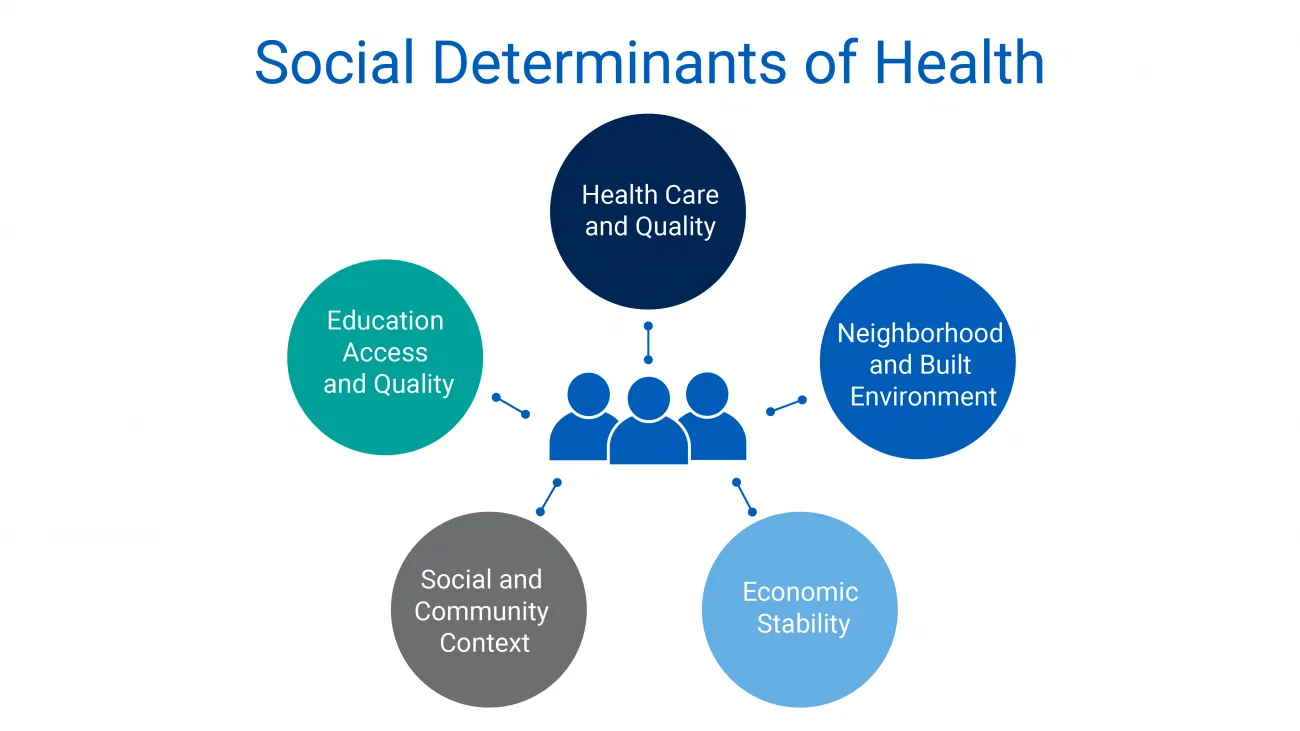We've joined our RTI Health Solutions colleagues under the RTI Health Solutions brand to offer an expanded set of research and consulting services.
SDoH Data Sources: The Keys To Unlocking Better Population Health Management Starts With Better Data
Individual data, neighborhood-level data, and a combination can be used to identify the best healthcare intervention strategies for high-risk populations.
Population health: social determinants play a more significant role than medical care
Moving the needle on health equity and SDoH begins with better data. As necessary and beneficial as quality, timely medical care is to population health management, data indicates that it accounts for approximately 10-20% of the modifiable factors influencing the health and well-being of Americans. The balance, roughly 80-90%, are linked to social determinants of health (SDoH).

What can be learned from social determinants of health?
The conditions in places where people grow, live, learn, work, play, and age vary by individual. When the array of variables is analyzed, archetypes emerge that are beneficial to designing healthcare and population health studies.
Databases that include social and community data are not new. Multiple algorithms have been widely available such as the ADI, SVI, County Health Rankings, and others. However, with the increased recognition of the impact social determinants have on health and the imperative to improve equity, better data tools are needed. Although SDoH data gathered directly from individuals is ideal, it is not yet a widespread or practical solution that can be readily implemented.
To address this need, our organization has developed an AI (artificial intelligence) tool that draws on more than 150 variables and random forest model to create Local Social Inequity (LSI) scores at the Census tract level. Named RTI Rarity™, this solution informs research by:
- Enabling researchers and data scientists to assess the impact of place-based inequalities in epidemiological and population health studies
- Providing a control for social and behavioral factors in analyses of care access, quality, and cost
- Surfacing patterns to aid identification of high-risk communities in evaluation studies
- Further, RTI Rarity offers insight necessary to form policies targeting root causes
The strength behind the LSI score created by RTI Rarity
Our RTI team began by expanding the Centers for Disease Control’s (CDC) Social Determinants of Health framework, which reflects 5 domains, to 10. Our multi-disciplinary team then identified and curated over 150 area-level measures related to inequalities in health and healthcare.
Our base model uses random forests to establish LSI, allowing us to better understand life expectancy at birth. This indicator strongly represents a person’s health and social inequity. By channeling our learnings, we’re also examining alternative models predicting other health outcomes like drug overdose mortality, infant mortality, and cancer mortality to help drive understanding of population-specific outcomes.
Imputed race, ethnicity, and SDoH data sources
The availability of individual-level data is problematic for reasons ranging from care access to health literacy to medical mistrust and beyond. When available, individual-level data helps identify who and what, and can reflect one’s circumstances that may change over time. For lack of this data, neighborhood characteristics can inform interventions for under-resourced or historically marginalized communities.
Historically, place-based indices of social risk factors have been based on a small number of variables resulting in limitations to predictive capabilities. Where these approaches fall short, RTI Rarity delivers with a neighborhood-level look at social drivers most predictive of neighborhood-level life expectancy.
About RTI Rarity
Our LSI score is valuable in many applications, including:
- Identifying neighborhoods in most need of interventions and resources to maximize impact
- Understanding the impact of healthcare programs in under-resourced communities
- Accounting for factors outside of providers’ domain to balance performance and quality measurement, risk adjustment, and reimbursement.
LSI scores are available:
- By each U.S. state and the District of Columbia (Census tract, ZIP code, county)
- For the entire U.S. (Census tract, ZIP code, county)
This data, along with a database of over 150 curated measures of SDoH, is most often deployed with RTI Health Advance’s health equity consulting and population health solutions.
Better population health management through data generating insight
SDoH will continue to be a major factor influencing health care outcomes in future years. Although individually collected SDoH data is ideal, many barriers currently exist that limit this approach. While waiting for widespread systems implementation of individual SDoH data collection, organizations need more precise and reliable databases to direct interventions and measure the impact of interventions. RTI Rarity is a dynamic, ever growing analytic platform that leverages artificial intelligence algorithms to provide organizations with better data to meet their needs.
Connect with RTI Health Advance to learn more about how RTI Rarity can provide precise insights to inform your health equity programming.
Subscribe Now
Stay up-to-date on our latest thinking. Subscribe to receive blog updates via email.
By submitting this form, I consent to use of my personal information in accordance with the Privacy Policy.